Scythe Kaze Flex II 120 in detail
Clockwise rotation fans are quite a rarity, you don’t normally come across them. However, Scythe, for example, makes such models and for good reason. Why not take it the other way around? In terms of standalone operation, of course, it doesn’t matter. In series, in the position of the second fan, it is possible to achieve higher cooling performance on CPU coolers compared to using fans with the same direction of rotation.
First, a general look at the main ways in which the Kaze Flex II 120 differs from the vast majority of other models and how the opposite direction of rotation is beneficial.
All of the fans we’ve tested so far rotate from right to left, but the Kaze Flex II rotates clockwise. This in itself does not affect the aerodynamic properties, and while keeping the same shape, but with the inverse geometry (to keep the leading edges in line with the direction of rotation), the key parameters (airflow and static pressure) naturally do not change. Nevertheless, such a fan can contribute to increased cooling performance in certain systems.
For the reasons mentioned above, Scythe also has fans with different rotation directions, namely in dual-tower coolers with a (front-to-back) fan/fin bundle/fan/fin bundle scheme. When the second fan, clamped by the finned towers, rotates in the opposite direction to the front fan, it picks up more air, to use the vernacular. However, this is usually at the expense of higher noise and efficiency (in the sense of cooling performance per unit of noise) can be, and in the experience of manufacturers, does end up being lower. This may not always be true for all fan combinations across the entire speed range, but this is basically the main reason why the coexistence of fans with opposing rotations is a rare occurrence.
Scythe uses clockwise-rotation with counterclockwise-rotation fans in the Fuma coolers (2 rev. B or the most recent 3). These combine the Kaze Flex II 120 with the Kaze Flex II 120 Slim.
Clockwise rotating fans are also tackled, for example, by Thermalright (TL-C12C), which we’ll get to sooner or later as well. But now to the analysis of the Kaze Flex II 120.
The rotor consists of eleven, relatively shorter blades. These are quite stiff, they don’t flex too much, which can be seen in the low vibration at top speed (around 2000 rpm). These are partially damped, in terms of transmission to the frame, by the softer rubber corners.
The angle of the blades is greater as is the spacing of their tips from the frame, and the spacing between adjacent blades is not that small either. These are all indicators to the fact that the static pressure at equal noise levels will be rather lower.
The Kaze Flex II 120 is available in three variants with different maximum speeds. The slowest, KFS1225FD12-P model maxes out at 1200 rpm, the KFS1225FD15-P, which is also part of the Fuma 3, at 1500 rpm and the tested KFS1225FD20-P at 2000 rpm. At that speed, moreover, Scythe promises an enormous airflow of 153.39 m3/h. And we will already note that with increasing rpm the airflow of this design increases significantly, but this alongside it also the noise level.
And one more thing: To navigate through the result graphs as easily as possible, you can sort the bars according to different criteria (via the button on the bottom left). By (non)presence of lighting, profile thickness, brand, bearings, price or value (with the option to change the sorting to descending or ascending). In the default settings, there is a preset “format” criterion that separates 120mm fans from 140mm fans.
- Contents
- Scythe Kaze Flex II 120 in detail
- Overview of manufacturer specifications
- Basis of the methodology, the wind tunnel
- Mounting and vibration measurement
- Initial warm-up and speed recording
- Base 6 equal noise levels…
- ... and sound color (frequency characteristic)
- Static pressure measurement…
- … and airflow
- Everything changes with obstacles
- How we measure power draw and motor power
- Measuring the intensity (and power draw) of lighting
- Results: Speed
- Results: Airlow w/o obstacles
- Results: Airflow through a nylon filter
- Results: Airflow through a plastic filter
- Results: Airflow through a hexagonal grille
- Results: Airflow through a thinner radiator
- Results: Airflow through a thicker radiator
- Results: Static pressure w/o obstacles
- Results: Static pressure through a nylon filter
- Results: Static pressure through a plastic filter
- Results: Static pressure through a hexagonal grille
- Results: Static pressure through a thinner radiator
- Results: Static pressure through a thicker radiator
- Results: Static pressure, efficiency by orientation
- Reality vs. specifications
- Results: Frequency response of sound w/o obstacles
- Results: Frequency response of sound with a dust filter
- Results: Frequency response of sound with a hexagonal grill
- Results: Frequency response of sound with a radiator
- Results: Vibration, in total (3D vector length)
- Results: Vibration, X-axis
- Results: Vibration, Y-axis
- Results: Vibration, Z-axis
- Results: Power draw (and motor power)
- Results: Cooling performance per watt, airflow
- Results: Cooling performance per watt, static pressure
- Airflow per euro
- Static pressure per euro
- Results: Lighting – LED luminance and power draw
- Results: LED to motor power draw ratio
- Evaluation





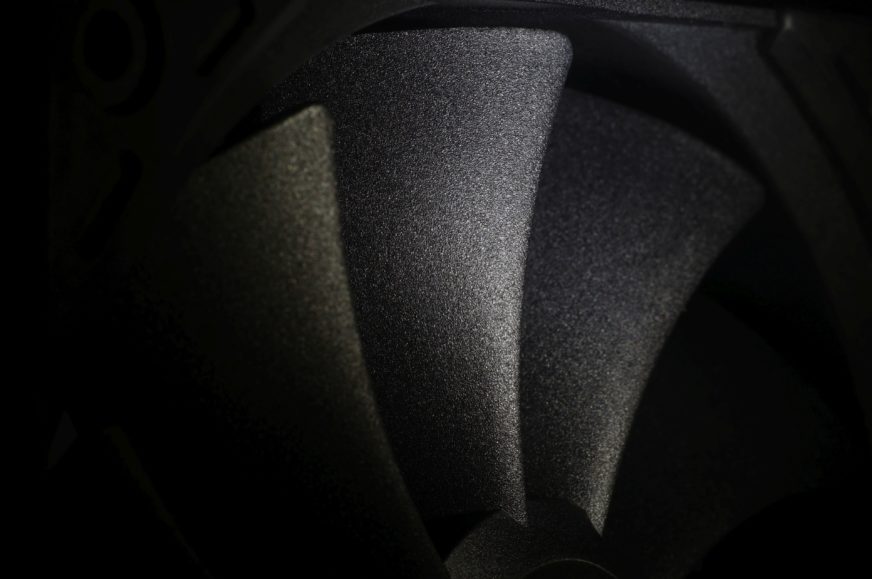
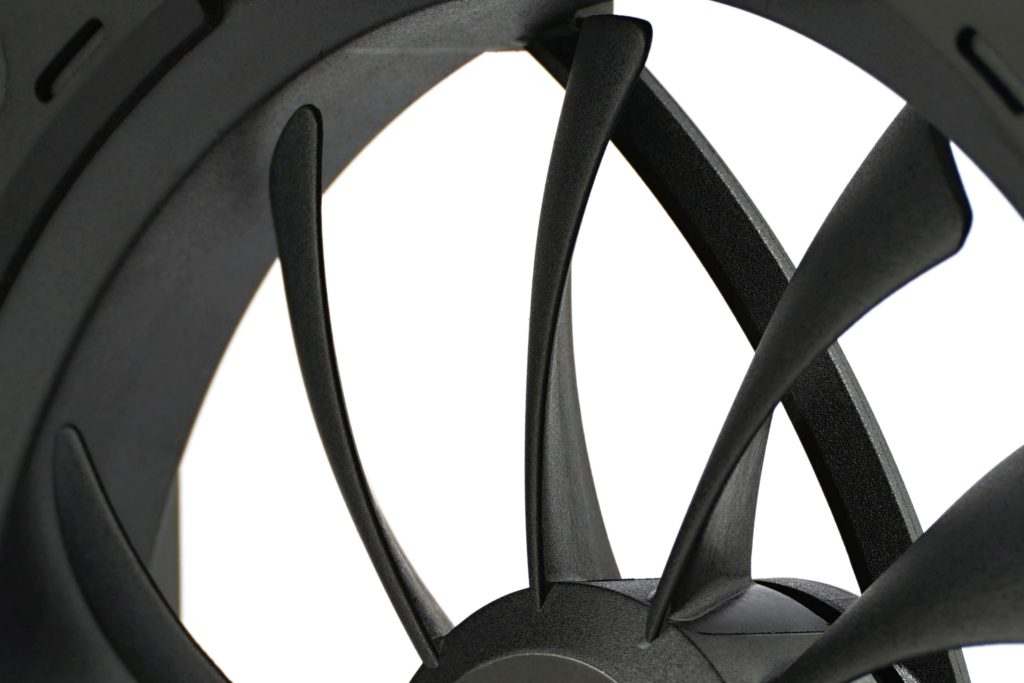
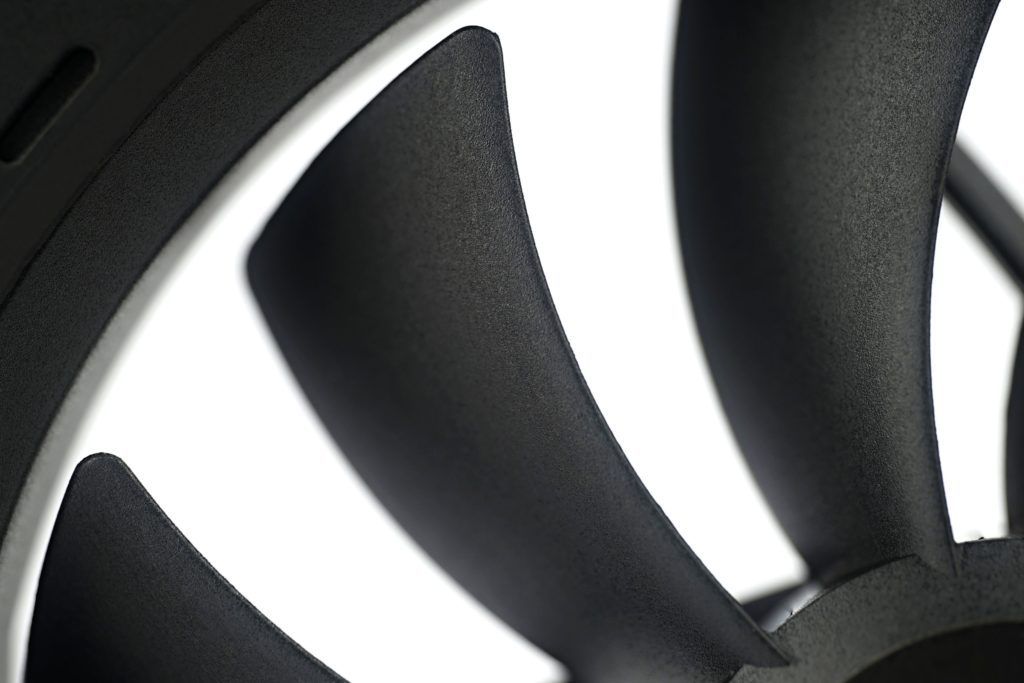
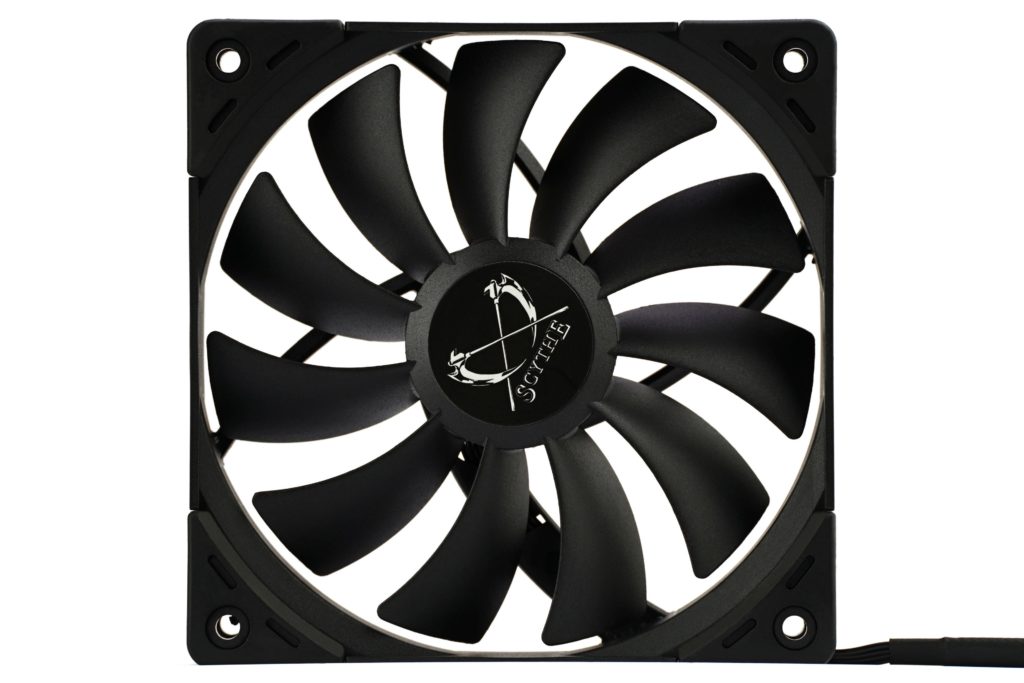
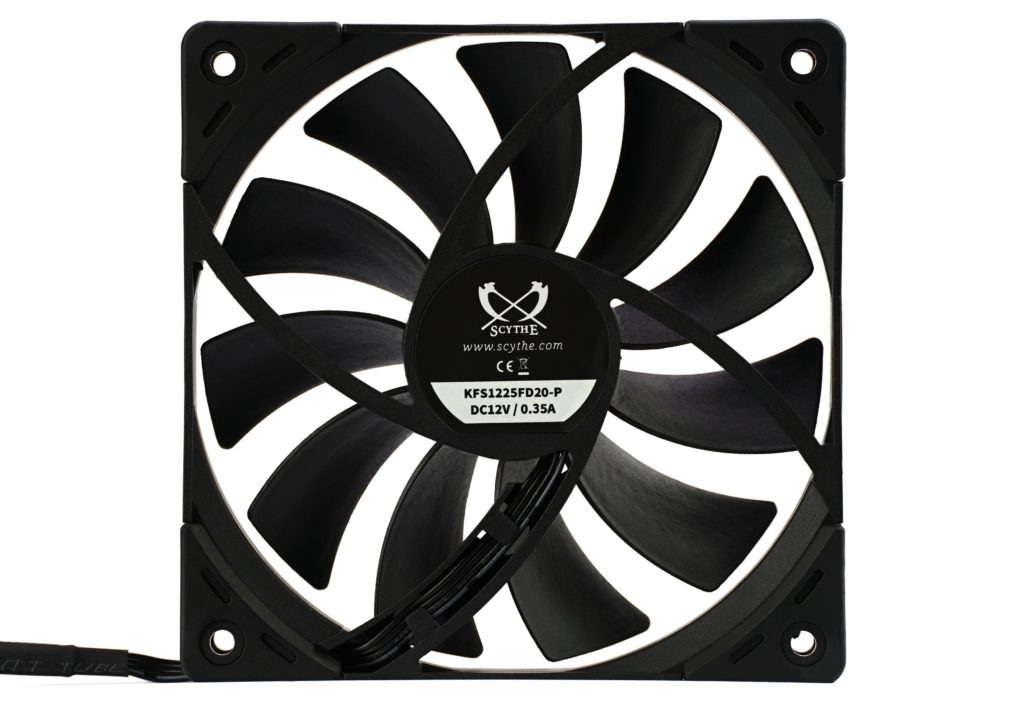
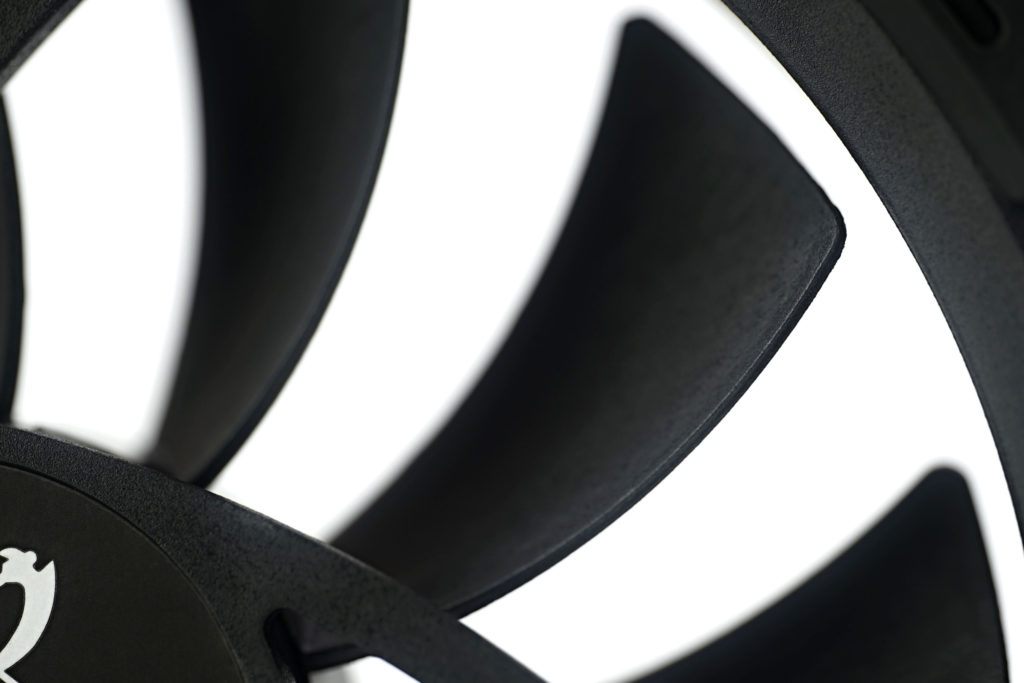
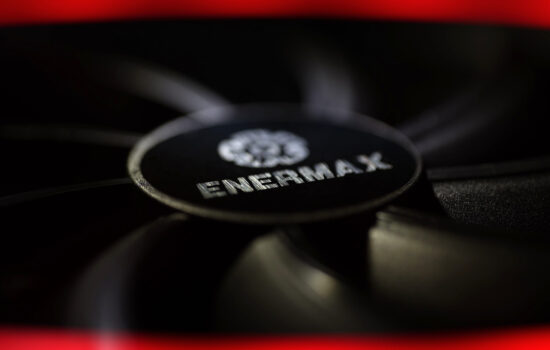





I wish it’s possible, somehow, to test whether opposing rotation directions actually brings a benefit. It is strange there are no one that I know (out of Scythe) uses opposing rotation directions in air coolers. There are GPUs using a similar setup but I am not sure if it actually works as as stated either.
It should be possible to test this on GPUs, since on some models the fans are identical except mirrored, and invidual fan parts are obtainable as repair parts. However, they are in parallel instead of in series so the situation is different.
On graphics card coolers it’s a slightly different situation, but the same direction of rotation should be the more powerful but noisier one – the blades lead the air against each other. And this is what most manufacturers of three-fan coolers try to avoid by making the middle fan rotate in the opposite direction of the other two, outermost ones.
We will try to test it in some way in a connection in series, although I don’t know how to make it so that the only variable is the direction of rotation. For that there would have to be a counterclockwise-rotating Kaze Flex II 120. This way we can test a standard configuration on the Fuma 3 and then one where the front Kaze Flex II 120 Slim is swapped for the Kaze Flex II 120. But it won’t be quite the same, as the Kaze Flex II 120 Slim is in many ways a different fan. On the other hand, if the initial fan configuration on the Fuma 3 achieves a higher cooling performance than after replacing the front fan with the Kaze Flex II 120, the effect of reverse rotation would be demonstrable. Anyway, it would still require two models with different direction of rotation, which otherwise have the same performance characteristics.
Maybe the Thermalright TL-C12C and TL-C12, which probably also use the same motor and bearings, could be close to this after alignment to equal speed. The only thing that might be a bit distorting is the material used to make the rotor with a slightly different stiffness. Any other ideas? 🙂
Good find. The Thermalright TL-C12/C12B (http://www.thermalright.com/product/tl-c12/, http://www.thermalright.com/tw/product/tl-c12-b/) and C12C (http://www.thermalright.com/product/tl-c12c/) seem to be identical except for rotation direction. I am sure someone like ThermalLeft would be more familiar with the fan models to know if there are any other differences (or if there are other fans being mirrors of each other).
Perhaps tests can be run by using a combination of these fans (and probably some other fans as well) on several different coolers, including a fan-swapped Fuma of course. The only variable that should be changing is the Thermalright fans. Though obviously you would need to validate that they are, indeed, identical except for the rotation direction first (though it would also make an interesting review if they perform differently). Why so many fans spin counterclockwise instead of the opposite is an interesting topic by itself.
I honestly don’t know why most fans are counterclockwise-rotating. I’ll try to look for it in circles of people who might know something about it. I have some ideas, but I don’t want to speculate.
Sure, thanks. TL-C12-B will probably be closer to TL-C12C than TL-C12. Perhaps an identical material could be used as well, as far as the elements used are concerned. The TL-C12 has a different colour, so at least to some extent it will be something a bit different, with possibly different blade stiffness.
Of course, the effect of combining fans with opposite rotation directions in dual-tower heatsink will have to be analysed across multiple heatsink. Scythe did not claim to have increased the cooling performance/noise ratio of the Fuma coolers in this way (but only the cooling performance…), but if with one heatsink there would be a faster growth of cooling performance than noise, i.e. a higher “efficiency” of the whole solution would be achieved, it does not mean that this will always be the case, of course. What we discussed last time in the article on psychoacoustic optimizations applies.
Different fin profiles may react differently to the same airflow, also acoustically. I believe that most other heatsinks that have been developed with the use of fans with the same rotation in mind will be characterized by more unpleasant tonal peaks than is the case with the Fuma 3. And it also cannot be ruled out that the average to below-average Kaze Flex II does a better job on the Fuma 3 (in terms of maximum cooling performance at equal noise levels) than it would appear from tests of the fan itself. It’s all about how, with the cooler as a whole, the developers have managed to eliminate tonal peaks across the frequency band.
I’m a complete novice here, but wouldn’t the Thermaltake SWAFAN with it’s swappable blades do what you want for testing alternating fans rotation?
Unfortunately, based on the official specs, the two rotors perform differently, with different airflow, static pressure and sound levels. This suggests that the blades are different, not just mirrored copies of each other. Even if the blades were perfectly mirrored, the stator is not symmetrical, which will lead to different characteristics of the overall fan.
Note the position of the leading edges of the Thermaltake SWAFAN rotor blades. Across variants they are not on the same side, while with the Thermalright TL-C12C-B/TL-C12C they are. This means that the TR fans move the air axially in the same direction (and only rotate the air streams in a different direction), while the Thermaltake fans move the air in the opposite direction.
It’s not Kaze Flex II, but I learned the important thing from testing other clockwise fans with a wind tunnel about 2 years ago. When I tested TL-C12 and TL-C12C without any airflow correction, I got the result which claims that TL-C12C has ~10% higher noise-normalized airflow than TL-C12. Of course, I realized something is wrong. TL-C12 and TL-C12C use the same impeller geometry, motor(4 pole motor, rifle bearing), and material(PBT), so the efficiency results of each fan should be similar.
When I re-tested them after adding a flow straightener between a fan and an anenometer, their result became approximately same. The cause of the first error was the direction of rotation. For my wind tunnel without a straightener, clockwise fans can take an unfair advantage that counterclockwise fans cannot have. This may come from rotation of turbulence inside a tunnel and the vane shape of my anenometer. Since that trials and errors, I have measured airflow with flow straightener despite the fact that it acts as strong obstacle against airflow.
Maybe your wind tunnel has no problem like my one? Your wind tunnel measures a ‘pulled’ airflow by a fan and the vane of the anenometer is flat, so may I assume that Kaze Flex II’s airflow result doesn’t have any distortion?
Plus, I didn’t know about Scythe’s Grand Tornado. I think it’s one of the best names for PC fans after Gentle Typhoon. 😀
Dealing with turbulence in a wind tunnel to achieve objective results is a rather complex topic in itself. It wasn’t that long ago that we were tinkering with all possible designs, including very long tunnels, and finally ended up with what we are using. Yes, we do test fans pulling air through the anemometer for a number of reasons. One of them is the one you have already hinted at – to significantly suppress turbulence in the anemometer passage, regardless of which fan is used. Of course, a symmetrical anemometer with flat blades is also needed for this.
The topic of “correct” anemometer placement in the tunnel is a bit of a skeleton in a closet. It’s not just about the position itself, but also the things around it that have to be in perfect harmony with a given placement. It’s impossible to write a few words on this, maybe one day I’ll publish a thick book on it, we have a plethora of data on it (from the early phases when the test methodology was going through various prototypes), all well documented. And the time will come when I will start to process it for the public. But for now it is still early, in my opinion very few people would be able to absorb it. We still have some way to go before it makes sense to go deeply into even such basic topics as the fact that push/pull result ratios in airflow measurements do not correlate with results where the temperature difference (push/pull) is observed in the context of a “cooling performance” analysis.
During the development of our methodology for testing fans, I have not come across many advantages that would play in favor of an anemometer in a “pushed” configuration. I know I don’t need to explain this to you, but I will just point out to everyone else that the position of the anemometer has nothing to do with the push/pull orientation of the fan with respect to an obstacle. But back to why the “pulled” tests proved to be a better option when it comes to comparing fans of all designs as accurately as possible. We have already discussed the first reason, significantly lower turbulence inside the tunnel and the smoothing of the air streams can be achieved on a significantly shorter path than in the “pushed” case. And there is no need for a straightener, which contributes a bit to the increase in tunnel resistance, which can distort the airflow results of fans with lower static pressure. Another thing is that when pushing the air streams into the tunnel, acoustic distortion also occurs to some extent depending on the shape of the specific trajectory – the air streams hitting the tunnel walls creates a different sound in the “conical” NF-S12A than in the “cylindrical” NF-A12x25 fan. This is then, of course, to a certain extent reflected in the setting of the individual modes in the framework of normalization to the specified noise levels.
Now I have taken this very, very superficially, and we will come back to the second and third paragraphs sooner or later, and in great detail, with the support of a great deal of measured data. It probably won’t be in a week, a month and maybe not even a year, but it will come out one day. It just has to make sense, it has to be useful for more than just a handful of people who will know what it’s about. 🙂
PS: Personally, I see technical issues with the ACMA 210 as well, but I won’t comment on them definitively until we get to the LongWin LW-9266. Of course I respect that instrument as a standardized device, but there is always that question “do its data come closest to the maximally fair comparisons?”
My further enhancement for a wind tunnel should reflect your opinion. I’m still using the current tunnel because of the financial problem, But I’ll finally change it into a design that measures a pulled airflow.
The deviation between Min and Max airflow is 3~5% now(the higher airflow, the higher deviation). By using pull position, maybe I can suppress a airflow deviation at slightly low or same level even without a flow straightener because as you said, pulled airflow will be less turbulent than pushed airflow.
Meanwhile, I already knew about the acoustic distortion that comes from the a tunnel. In the past, I processed noise-normalization for fan with it installed on wind tunnel. It was a similar methodology with yours, but the problem is that I did not consider the acoustic effect of my tunnel when I had designed it. After I finished the airflow test, I got the noise – airflow result that says the order of PH-F120MP V2 > NF-A12X25 > PH-F120T30 for radiator push environment. This was obviously wrong. The cause of my fatal error was my ignorance about the noise distortion. So, I have been doing noise-normalizations with a PC case from then to resolve the problem. After I started to use PC case for noise-normalization, results of those fans became similar with other tester’s data. (NF-A12X25 ≥ PH-F120T30 > PH-F120MP V2)
Maybe I’ll stay at the method with PC case, because I’m really not an expertise about airflow – wind tunnel – noise interactions. Although there is a matter that there is a slight difference (within 100RPM at same PWM) between rotational speed measured at case and that measured at wind tunnel, it is difficult to modify the current design now. I need further research by myself before designing a tunnel that can minimize acoustic effect.
I’m looking forward to a lot of data that will be released someday. It will really help to offer detailed explanation about measurements for fans.
Of course, a wind tunnel always increases the noise level, it cannot be completely avoided. But as long as a) it is not a measurement confronting the specifications and b) the increase in noise is “fair” for each fan, everything is fine in my opinion. But to the main point:
1.) As we have already discussed above, when air streams are circulated by the tunnel, it can have quite a significant effect on the noise level of the whole system, if we consider the fan + tunnel as a system. When comparing the situations of pushed airflow, pulled airflow in relation to the tunnel and then free space flow (preferably with the fan attached to rubber bands, far and wide without obstruction), the lowest noise will of course be achieved in this third case, then usually with pulled airflow and finally with pushed airflow. Of course, it also depends on the design of the tunnel itself and the larger the cross section, the smaller the difference between pushed and pulled airflow will eventually be. The problem, and this is not objective, is that with pushed airflow the increase in noise (compared to free space measurement) can be different for each fan, which I consider to be quite unfair and distorting. The more conical the trajectory, the greater the increase in noise at the same airflow can possibly be the case when air is pushed into the tunnel. In a free space or other situation, such a fan can be quieter. Pulled airflow eliminates this quite well, because the air stream is forced into the free space, where among other things the tunnel has less resistance with respect to the fan, which in turn is useful for other reasons.
Naturally, even in a pulled airflow situation, where the air flowing through the tunnel is less turbulent, there is always an increase in noise, but from our observations the increase is always about the same regardless of which fan is on there. Nevertheless, in some cases, due to the design of the tunnel, some fans may produce resonant frequencies and tonal peaks which should be dealt with, as they naturally present a significant distortion when tuning to equal noise levels. But this is beyond the scope of the comments below an article. We will certainly, when the time comes, discuss these findings in an article.
2.) Tunnel noise is naturally a problem if the aim is to verify the noise parameters given by the manufacturer. But this is only one of the elements and it does not bother us very much when comparing fans as accurately as possible. Frankly, I have never had the ambition to measure noise according to standards and norms. Apart from the fact that it requires extremely expensive equipment, in the end I still wouldn’t get to the data that I consider to be important for practice. Measuring noise from a distance of one metre, even in a perfect anechoic chamber, means that the small details that make the difference between a very good and a great fan are lost from the sound. Of course, everyone can see this differently, it depends on who wants to achieve what with their measurements. It is true that with different noise measurement procedures, the possibilities for reproduction of the measurements decrease and sometimes it is harder to find the “common ground”. Recently, we have discussed the Magflow fan with Seasonic because it has quite pronounced tonal peaks at higher frequencies, and naturally, when someone records the sound of the same fans from a distance x times greater, the spectrograms look a bit different (and the peaks suddenly don’t look so scary anymore).
There was one more thing that came to my mind with regulating the fan to equal noise levels externally. Namely, that the thing with which the fan is in contact (for example a case) is also to some extent a source of sound depending on the vibrations on the frame. The proportion of “amplification” by the noise of the structure that holds the fan can also be different and elimination of these phenomena is extremely difficult. We have solved this by using a holder made of a material that does not get into significant resonance frequencies with the typical fan vibrations, and to ensure that the tunnel never resonates, soft mounting using silent blocks with lower hardness was necessary. In short, we have done everything to avoid this external measurement, which also increases the time effort by requiring more assembly work (at the place of normalization and then at the place of other measurements) or work around the data transfer from place to place. With CPU coolers I used to noise-normalize them in a different chamber than the tunnel in which the cooling properties were subsequently measured.
So much from my point of view on the basic things about noise measurement. It’s a very complex topic that can be discussed endlessly (and also in regard to the “appropriate” position between the sensors of the noise meter/microphone and the fan itself), but that’s why we enjoy it and I’d like to conclude by reiterating one thing. In the end, the most important thing for the people we are doing it for is always whether we come to comparable conclusions across methodologies. The slightly different details of the measurements do not matter so much, that is often nitpicking. Your fan tests and tests from QM오즈 are the only ones that interest me personally. I’ll look into the Hardware Busters results as well, but more than for practical reasons for the use of ACMA 210. So I keep my fingers crossed for your further work, you are doing a really good job! When one finds out over time that one has not evaluated something optimally and puts on sackcloth and ashes (in your case in excessive amounts), it is always very respectable. So few people have such a strong self-reflection, hats off to you.
Thank you for the substantial insight again!
Regarding the noise from a tunnel, I understand the brief principle of an acoustic interaction between tunnel and fan: Although even a tunnel with pulled airflow measurement always increases entire noise level, it makes approximately equal acoustic impact for each fan when fans make same airflow, by eliminating contribution of a wind stream trajectory which is pushed by a fan.
I’ll try to check this mechanism with my wind tunnel after finishing the current projects. Measuring the aumentation of a noise level at a same rotational speed might be enough to check it simply.
Meanwhile, I agree about the convenience of measuring noise with a fan mounted in a tunnel. It is really time-cosuming work to noise-normalize a fan, depart it from a noise bench, install it at a tunnel and seal some gaps. There are so many procedures. Nevertheless, I think it’s a problem that can be solved if I’m more diligent.
Operating fan at any structure makes a difference at noise, as you said. I think that if this problem cannot be resolved completely, measuring a noise level at PC case can be a good second workaround for me. PC fans are usually mounted at PC case as their purpose so that this method with a case may be reasonable.
On the other hand, the effort to reduce a noise amplification by vibration not only enhances the fairness of test, but will also help users at a practical aspect. (for example, applying QM오즈’s spring method to real cases?)
Maybe I’m continuing to look back and criticize my methodology because I always eager to make my work better than yesterday. Is it too many amounts of ashes? 😀 If I made no development.. I would stay at a low level:
https://img2.quasarzone.com/editor/2022/01/19/bb863e391cf36c3844ab7ba69c26c078.jpg
Anyway, thank you for the compliment and the advice that motivates me and inspires another comparison method.
I appreciate you for taking the time to reply in detail.
I’m really glad that we can discuss here together like this. Your testing of fan noise in cases has taught me one thing. Namely, that even a small sheet metal in front of the rotor is enough to achieve high tonal peaks. For a long time, I’ve associated this with a lot of edges on a large surface area and yet it’s something a little different. 🙂
“Operating fan at any structure makes a difference at noise” … and here it depends on what vibrations a fan transfers to the frame. I am afraid that their influence could distort the assumption “Although even a tunnel with pulled airflow measurement always increases overall noise level, it makes approximately equal acoustic impact for each fan when fans make the same airflow, by eliminating contribution of a wind stream trajectory which is pushed by a fan.” Of course, it also depends on the design of the tunnel and whether the tunnel can eliminate the resonant frequencies, that will contribute to the secondary noise, across the entire vibration spectrum of all the fans tested. We have been working for some time to ensure that even the fans with the highest vibrations do not transmit any vibrations to the tunnel and thus do not increase the overall noise level of the measurement system. This is what slowed down the development of the whole methodology and it was quite difficult to achieve the desired result. Especially when we had more requirements for the mounting system (also around vibration measurements and so on). Soft mounting, but at the same time tight fit will be beneficial in this respect. The higher the speed, the higher the vibrations, the higher the share of noise the tunnel itself can eventually have. Especially if it is composed of relatively light materials.
* Edit: cosuming -> consuming